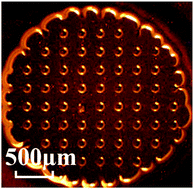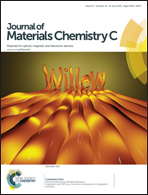Fabrication of flexible microlens arrays through vapor-induced dewetting on selectively plasma-treated surfaces†
Abstract
Microlens arrays have been increasingly employed as key components in building micro-optical systems. Conventional fabrication methods, such as grayscale lithography, ink-jet printing, and photoresist thermal reflow, are often constricted by certain drawbacks, including mask resolution, high fabrication cost, and complexity of processes. In this paper, we present a low-temperature dewetting method that enables fabrication of microlens arrays on polymeric surfaces in a rapid and cost-effective way. As the demonstration of such a technique, vapor-induced dewetting of SU-8 thin films has been carried out on heterogeneous polydimethylsiloxane (PDMS) substrates that were selectively pre-treated with low-energy sulfur hexafluoride (SF6) or oxygen (O2) plasma. The dewetted SU-8 droplets are self-organized to directly form well-aligned microlens arrays on the O2-plasma-treated regions, with various lens curvatures ranging from ∼27° to ∼47° as the processing temperature rises from 20 °C to 80 °C. The exposure to the solvent vapor allows for the realization of dewetting at low temperatures. The optical performance of such microlens arrays has been characterized by testing their imaging capabilities.


 Please wait while we load your content...
Please wait while we load your content...